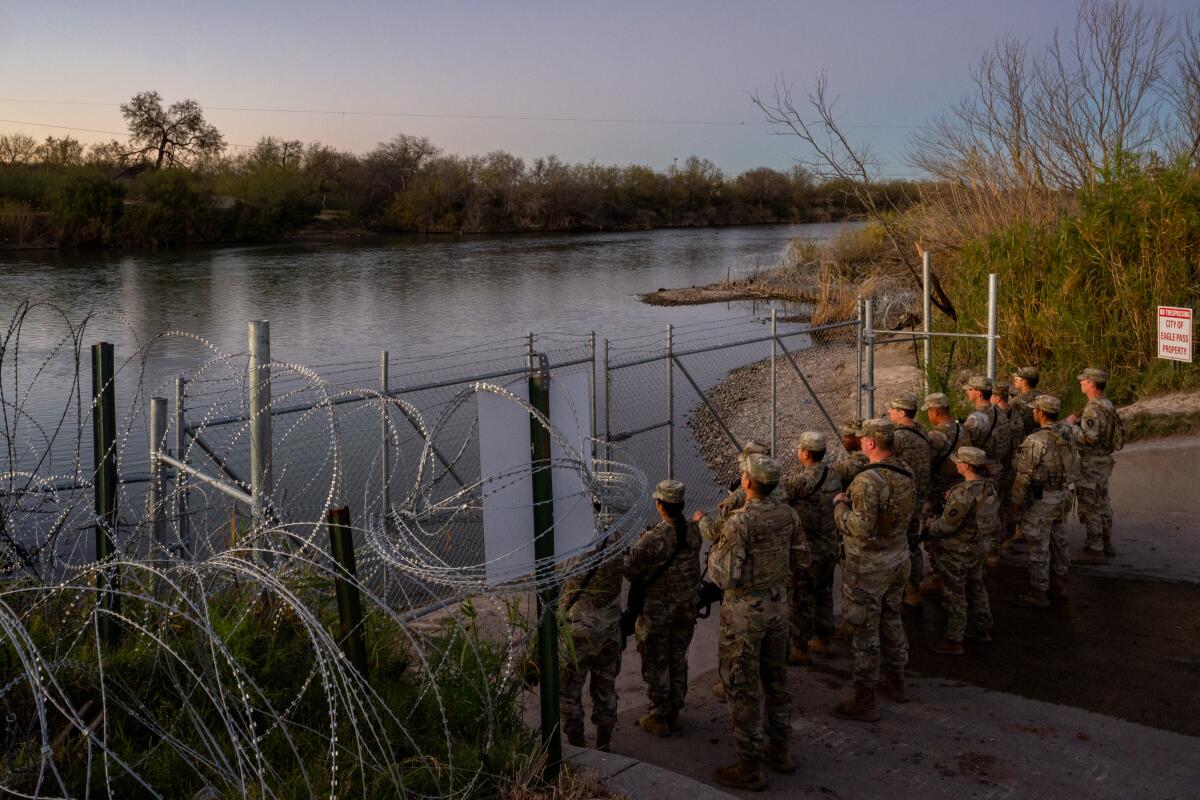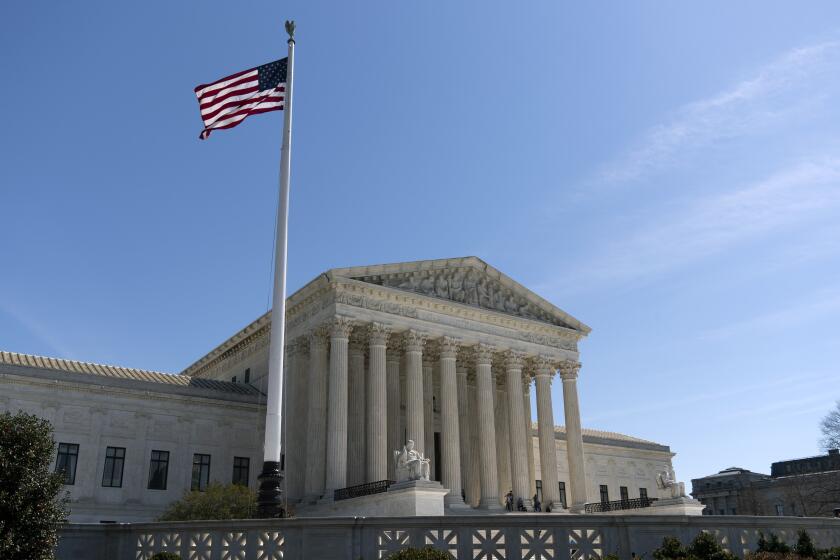America needs an immigration debate — just not the one we’re having

- Share via
WASHINGTON — Immigration will figure prominently in the 2024 presidential campaign, continuing its run as one of the nation’s longest-running and most divisive issues.
Republicans plan to feature the troubles at the southern border as evidence for their argument that President Biden is failing. Former President Trump has amped up his already inflammatory anti-immigrant rhetoric, accusing migrants of “poisoning the blood” of Americans.
He focused on the subject again in his speech after winning Monday night’s Iowa caucuses, saying that if he were elected he would enforce “a deportation level that we haven’t seen in this country in a long time ... since the Eisenhower administration.”
Democrats find themselves on the back foot. Public support for immigration, which rose during the Trump years, has sunk since Biden took office, no doubt partly because of chaotic scenes at the border. While immigration issues unify Republicans, they divide Democrats.
The Times’ most recent UC Berkeley Institute of Governmental Studies poll of California voters provided clear evidence of the party’s divisions: Asked whether immigrants in the U.S. without authorization have created a burden for the country, Republican voters almost unanimously said they did.
Democrats were divided, with about 1 in 5 saying the migrants created a “major burden,” 2 in 5 saying they created a “minor burden” and about one-third saying they were not a burden.
Sidestepping the big issue
The result is a one-sided debate: Republicans have relentlessly been on the attack, and Democrats have taken a defensive crouch.
For the last couple of months, the White House, for example, has been trying to make concessions to Republicans in hopes of reaching a compromise on border security. So far, the talks haven’t achieved their goal, but the debate has further soured relations between the president and his party’s left wing.
As the debate has droned on, neither party has seriously tried to grapple with the biggest issue: Just how many immigrants does the U.S. need?
The immigration trade-off
For any country, immigration poses a trade-off. On the one hand, newcomers bring new ideas, new resources and welcome vitality. The poll of American immigrants that The Times did last year with KFF, formerly the Kaiser Family Foundation, vividly illustrated how immigrants today are the keepers of the flame when it comes to optimism about the future — once a hallmark of American society.
But high levels of immigration can also bring social instability. Large numbers of unskilled immigrants can depress wages in certain parts of the economy, at least for a time. And new residents with new customs can generate a backlash, as the U.S. has vividly seen in recent years.
Striking the right balance is complicated, but it starts with grappling seriously with the question of what level of immigration would be optimal.
The answer: A lot more — at least if the U.S. wants to slow the graying of its population and stave off long-term population decline, demographers say.
Declining population growth
This decade probably will experience the smallest percentage population growth in U.S. history, said Brookings Institution demographic expert William Frey. That’s partially the result of the COVID-19 pandemic, which increased death rates and caused some couples to postpone having children. But even with the pandemic receding, the U.S. is heading for very little growth in the years to come.
That’s a huge change from the past. Since 1900, the U.S. population mostly grew between 1% and 2% each year. The exceptions came during traumatic periods — the Spanish flu epidemic of 1918-1919, the Great Depression.
Now, according to Census Bureau projections, the country is, at most, likely to have about 4% population growth over this entire decade. The rate will slow further after that.
Should you worry about that?
Some people would say no. Among environmental activists, for example, some take the view that fewer Americans would be a good thing because our lifestyle uses more resources than in other countries.
But there are other ways to reduce the American impact on the global environment — greater reliance on renewable energy, for example.
And a U.S. population decline imposes real, and heavy, costs.
If you plan to retire, or care about the country’s military strength or its economy, an aging or declining population is definitely something to be concerned about.
An older population with a shrinking number of workers makes paying for Social Security or other retirement programs much harder, for example, because there are fewer workers to support a growing number of retirees.
Countries such as Japan and Italy, which are aging faster than the U.S., are already experiencing the problems that population decline brings. Even China, which decades ago adopted drastic policies to hold down its population, is now anxiously trying to restart population growth.
Those countries, notably, don’t allow much immigration.
1 million a year. Or more?
The chief reason for slower growth is a demographic shift that the U.S. shares with almost every other wealthy, developed country: Women are having fewer children, and the population, on average, is getting older.
The U.S. staved off that decline longer than most developed countries, mostly because of “healthy immigration levels from the early 1980s to around the 2010s,” Frey said.
But starting in 2007, with the onset of the Great Recession, population growth rates tumbled and have not recovered.
What population growth has occurred has mostly been due to immigration, Frey recently reported, based on an analysis of census data.
The number of immigrants entering the U.S. slowed sharply during Trump’s years in office, in part because of new restrictions on legal immigration. Under Biden, the level has rebounded to about 1 million in 2021 and 1.1 million in 2022.
But even at a rate of 1 million new arrivals a year, U.S. population growth would flat-line in about 40 years and then slowly begin to decline, the census says. If immigration were held to the level of the Trump years, the U.S. population would level off in about 15 years and go down after that.
Conservative advocates of less immigration sometimes argue that a decline can be avoided with policies that would entice women into having more children. So far, however, such policies have almost universally failed in countries that have tried them, and even rudimentary pro-family policies, such as subsidized child care, have failed to be approved in the U.S., largely because of opposition from the same conservative political figures who want less immigration.
In the absence of a dramatic, and wholly unlikely, increase in the U.S. birthrate, keeping the population growth at something close to the historical average would require what the census describes as a “high immigration” scenario — about 1.5 million immigrants a year.
Perhaps, as Trump and his allies believe, Americans simply won’t accept that level of newcomers. If that’s the case, however, there’s an inevitable price to pay: an aging population, a declining workforce and a less vibrant America.
A presidential campaign would be a good opportunity to focus voters on that trade-off. But don’t bet on it.
There’s little evidence that America’s gridlocked political system is capable of such a straightforward debate.
More to Read
Get the L.A. Times Politics newsletter
Deeply reported insights into legislation, politics and policy from Sacramento, Washington and beyond. In your inbox twice per week.
You may occasionally receive promotional content from the Los Angeles Times.











